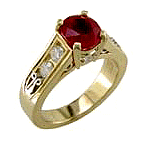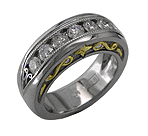
Some Famous RingsBy M. J. Onahan |
[Editor's Note: The following wonderful article by Mary J. Onahan presents the intriguing, and at times surprising history, of several important rings. Here you will learn: what happens to popes after they die, how an enormous ring was presented to President Pierce by the citizens of California, and why we "commit our pretiosities" to the fourth finger of our left hand.The history and poetry of rings is more curious and more fascinating than that of dynasties and of princes. A ring has been the symbol of power; it has been also the mark of slavery; affection and friendship have wrought it into a remembrance; love has placed it encircling with its gentle pressure a vein supposed to vibrate in the heart. Millions upon millions have been bound together with it for better, for worse, more firmly than ever shackles have bound a felon. It decks the finger of the blushing maiden standing shyly, half reluctant, wholly willing, at the portal of Love's sweet fane; it gleams bright and pure and steady upon the hand of the new-made wife, token of the love she vowed; it shines, though none can see, in the darkness of many a coffin, emblem of the man's immortality. The origin of the ring is shrouded in mythology. The old story of Prometheus is well known; how Jupiter in a fit of rage chained Prometheus to a rock on the Caucasus and sent a vulture to feed upon him. According to Hesiod, the god had sworn to keep him there eternally; according to other authors, his rage was not so boundless. At any rate, so the story runs, even the terrible Jove relented and pardoned Prometheus; but in order not to violate his oath he commanded that he should always wear upon his finger an iron ring in which was fastened a small fragment of Caucasus, so that it should still be true in a certain sense that Prometheus was bound to the rock. This was the origin of the ring, according to Hesiod, as well as the insertion of the first stone. On the other hand, Pliny declares that the inventor of the ring is not known. It was in use among the Babylonians, Persians and Greeks, although the latter were probably unacquainted with it at the time of the Trojan War, as Homer does not mention it. Southey's Commonplace Book contains the following quotation from the Treasure of Auncient and Moderne Times: "But the good olde man Plinie can not overreach us with his idle arguments and conjectures, for we read in Genesis that Joseph, who lived five hundred years before the warres of Troy, having expounded the dreame of Pharao, King of Egypt, was by the sayde prince made superintendent over his kingdom, and for his safer possession in that estate, he took off his ring from his hand and put it on Joseph's hand. In Moses' time, which was more than foure hundred yeares before Troy warres, wee find rings to be then in use; for wee reade that they were comprehended in the ornaments which Aaron the high-priest should weare, and they of his posteritie afterward; as also it was avouched by Josephus. Whereby appeareth plainly, that the use of rings was much more ancient than Plinie reporteth them in his conjectures; but as he was a pagan, and ignorant in sacred writings," the old chronicler goes on to add, "so it is no marvel if these things went beyond his knowledge."
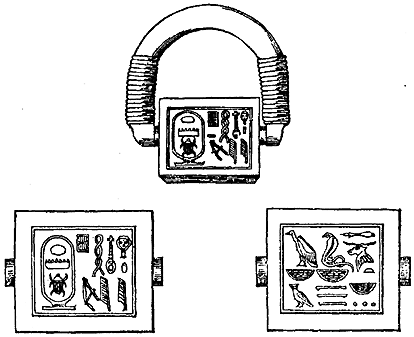
Joseph's Ring Found in a Tomb Opened in 1824 The ring given by Pharao to Joseph is actually in existence, and is now in the possession of the Earl of Ashburnham. It was discovered in 1824 by Arab workmen in a tomb in the necropolis of Sakkara, near Memphis. The mummy was cased in gold, each finger had its particular envelope, inscribed with hieroglyphics. "So Joseph died, being an hundred and ten years old, and they embalmed him and he was put in a coffin in Egypt." Joseph's ring, though one of the most valuable antiques in the world, is put quite in the shade by another ring, older still - the ring of Suphis, or Cheops, King of Memphis, who erected the Great Pyramid for his monument. Like all the Egyptian rings, it is covered with hieroglyphics, figures of Isis, Osiris, the lotus, the crocodile, and the whole symbolic Egyptian mythology. This ring is now in New York in the possession of a famous collector.
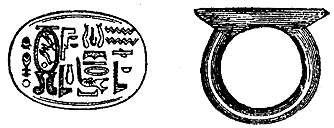
Ring of Cheops, the Most Valuable Antique Ring in the World Rings have been discovered in the cinerary urns of the Greeks; as they could scarcely have withstood the fire through which dead bodies were passed, they must have been placed there as tokens of affection by relatives or friends. It was against the laws of Rome to bury gold with the dead, so that the rings found in Roman urns must have been secreted there. There was one curious exception to this rule, which seems like a bit of satire on our vaunted modern progress. The gold that fastened false teeth in the mouth of the deceased was exempt and might be buried with the body. Dentistry has not made such wonderful progress in these two thousand years after all. Skeletons of Roman knights have been discovered in the tombs of the Sierra Elvira, in Spain, with rings upon their fingers, and some of them had in their mouths a piece of money in the form of a ring destined to pay the ferryman Charon. What a pity that the modern world can no longer avail itself of such billets d'admission! The old ferryman has fallen into decrepitude and disrepute, his occupation gone, his authority entirely annulled. According to modern belief, when men set out on their journey to that unknown shore they must leave gold and silver behind them. Good deeds are the only coins that are current. Rings were in use among the Gauls and Britons. William de Belmeis gave certain lands to St. Paul's Cathedral, and directed that his ring, set with a ruby, should, together with the seal, be affixed to the charter for ever. Jewellers and goldsmiths were highly esteemed in those days. "Even the clergy," says Edwards in his very curious book on rings, "thought it no disgrace to handle tools. St. Dunstan in particular was celebrated as the best blacksmith, brazier, goldsmith, and engraver of his time. This accounts for the cleverness with which he laid hold of the gentleman in black: "St. Dunstan stood in his ivy'd tower -Rings have been made of almost every hard substance known, gold, silver, bronze, iron, stone, ivory, porcelain, amber, jet, and even of glass. The first mention of a Roman gold ring is in the year 432, but they soon came to be indiscriminately worn. Three bushels were gathered out of the spoils after Hannibal's victory at Cannae. The Romans not only cumbered their fingers with a great number of rings, but some of them were of extraordinary weight and size. An outline of one appears in Montfaucon. This ring represents Trajan's good queen Plotina. She has a glorious head-dress indeed, three rows of precious stones cut in facets.
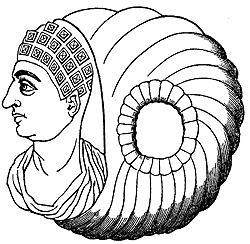
Roman Ring of Trajan's Queen Plotina Rings have been worn on all fingers of both hands, but the fourth finger of the left hand has been preferred to all others from the earliest times; hence it is called the ring-finger. Apropos of this subject a charming old work, Enquiries into Vulgar Errors, says: "That hand (the left) being lesse employed, thereby they were best preserved, and for the same reason they placed them on this finger, for the thumbe was too active a finger, and is commonly employed with either of the rest; the index or fore finger was too naked whereto to commit their pretiosities, and hath the tuition of the thumbe scarce unto the second joynt; the middle and little fingers they rejected as extreams, and too big or too little for their rings; and of all chose out the fourth as being least used of any, as being guarded on either side, and having in most this peculiarity, that it cannot be extended alone and by itselfe, but will be accompanied by some finger on either side." The episcopal ring is esteemed as a pledge of the spiritual marriage between the bishop and his church, and was used at a remote period. The decrees of the Roman See are signed with a seal known as the Fisherman's Ring. This ring forms an important feature in the funeral rites of a pontiff. The following is an account of the ceremonies attendant on the death of a pope: "When a pope dies the cardinal chamberlain, accompanied by a large number of the high dignitaries of the Papal court, comes into the room where the body lies, and the principal or great notary makes an attestation of the circumstance. Then the cardinal chamberlain calls out the name of the deceased pope three times, striking the body each time with a hammer; and as no response comes the chief notary makes another attestation. After this the cardinal chamberlain demands the Fisherman's Ring, and certain ceremonies are performed over it; and then he strikes the ring with a golden hammer, and an officer destroys the figure of Peter by the use of a file. From this moment all the authority and acts of the late pope pass to the College or Conclave of Cardinals."
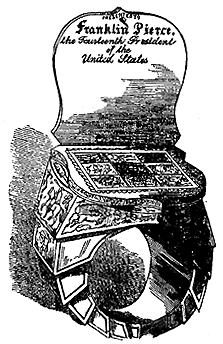 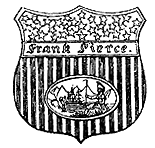
Ring Presented by Citizens of California to Franklin Pierce One of the most curious as well as one of the most valuable of American rings is that presented to President Pierce in 1852 by the citizens of California. It is of massive gold, weighing upwards of a pound; the circular portion is cut into squares which stand at right angles with each other, and are embellished each with a beautifully executed design, the entire group presenting a pictorial history of California from her primitive state down to the present time. The seal of the ring is really a lid which swings upon a hinge, and is covered with the arms of the State of California surmounted by the Stars and Stripes. Underneath is a square box divided by bars of gold into nine separate compartments, each containing a pure specimen of the varieties of ore found in the country. On the inside is the following inscription: "Presented to Franklin Pierce, the Fourteenth President of the United States." The rings in which poison was carried are numerous. Dumas, in his Crimes Celebres, tells of a ring worn by Caesar Borgia composed of two lions' heads, the stone of which he turned inward when pressing an enemy's hand. The teeth were charged with poison. Needless to say the enemy never called again. In older and more credulous times than ours even the stones themselves were believed to have certain powers quite apart from any such vulgar agency as poison. Such staid authorities as Albertus Magnus and St. Jerome seem to have countenanced this belief. The diamond was supposed to give one the power of conquering enemies, it was also a safeguard against poison; the emerald was at enmity with all impurity; the topaz freed men from sadness; the agate made a man brave and strong; the sapphire procured the favor of princes; the opal sharpened the sight, etc. In ancient times men, when dying, declared by the giving of a ring who was to be their heir. In Ireland rings of remarkable beauty have been found. We all remember Moore's lines: "Rich and rare were the gems she wore,which was, indeed, as some one remarks, a thoroughly Irish way of wearing a ring. This was in the time of good King Brian, who " . . . knew the wayThat "de'il o' Dundee" also had a ring of which the inscription, a thoroughly characteristic one, is still remaining. Rings as love-tokens are as old as Love itself. Old Roman rings have been found in which was a tiny socket for the insertion of hair; others had a whistle on one side (a case of "Whistle, and I'll come to you, my lad." no doubt). Louis IX of France wore a ring representing a garland of marguerites and fleurs-de-lis, in allusion to the name of his wife, Queen Marguerite, and the arms of France. Engraved on it were these words: "This ring contains all we love." Not only hearts but cities have been wedded with a ring. Venice, that "white sea-gull of the Adriatic," was once annually married with a ring. The stranger can yet see the richly gilt galley, called the Bucentaur, in which the doge, from the year 1311, went forth on Ascension morning to throw a ring into the water, as a sign of the power of Venice over that sea and of the union which he renewed between them. Thus, for better, for worse, in the vowing of Life and the dealing of Death, these little emblems have swayed the world. What is all creation, indeed, but a ring - a ring that means at once Power and Love Eternal? It is on the earth, in the sky, everywhere. Above our heads it shines as Saturn gleams blue and bright upon the horizon, showing us how the world was made. Farther still, millions and millions of miles, rising through deserts of space in Ariadne's Crown, it rests like a wreath of promise on the very zenith of the universe; and as men gaze into those starry depths they see, shining bright and clear, symbol of their earthly vows, a ring, emblem of Life, of Hope, of Love, of Immortality.
* * * * *
At Bijoux Extraordinaire we help our clients create beautiful custom rings.
Here are a few of our recent creations ....
|
|
|
||
|
| Bijoux Library | Jewelry Galleries | What's New! | | Bijoux Home Page | About Us | Services We Offer | Site Map | If you have any questions, suggestions or comments, please give us a call (603 624-8672) or send us an email.
|
||
|
|
||
